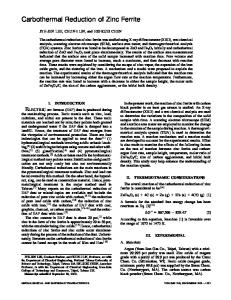Catalytic Reduction of CO 2 into Solar Fuels via Ferrite Based Thermochemical Redox Reactions
- PDF / 751,013 Bytes
- 7 Pages / 612 x 792 pts (letter) Page_size
- 73 Downloads / 285 Views
Catalytic Reduction of CO2 into Solar Fuels via Ferrite Based Thermochemical Redox Reactions Rahul R. Bhosale1, Anand Kumar1, Fares AlMomani1, Majeda Khraisheh1, Ivo Alxneit2 1 Department of Chemical Engineering, Qatar University, Doha, Qatar. 2 Bioenergy and Catalysis Laboratory, Paul Scherrer Institute, CH-5232 Villigen, Switzerland. ABSTRACT In this study, Ni based ferrite nanomaterials were synthesized using sol-gel method for solar thermochemical splitting of CO2 using a thermogravimetric analyzer. To synthesize the ferrite materials, the corresponding metal precursors were dissolved in ethanol (with required molar ratios). After achieving the dissolution, propylene oxide (PO) was added to achieve the gel formation. Freshly synthesized gels were aged, dried, and calcined by heating up to 600oC in air. Powder x-ray diffractometer (XRD), BET surface area, as well as scanning (SEM) and transmission (TEM) electron microscopy characterized the calcined powders. The sol-gel derived ferrites were further tested towards their thermal reduction and CO2 splitting ability using a high temperature thermogravimetric analyzer (TGA). INTRODUCTION To synthesize liquid transportation fuels such as gasoline, diesel, and jet fuel via the Fischer Tropsch process, syngas i.e. a mixture of H2 and CO is used as the feedstock[1]. To avoid the utilization of the fossil fuels for the production of liquid transportation fuels, solar driven thermochemical splitting of H2O and CO2 using metal oxide based redox reactions is considered as a promising new technology[2-3]. It is a two-step process which utilizes redox reactions of mixed valence metal oxides. In step-1, the thermal reduction of the metal oxide is carried out at higher temperatures using solar thermal energy, which results into release of O2. (1) The reduced metal oxide is re-oxidized in step-2 via H2O/CO2 splitting reaction producing H2/CO. (2) The step-1 is endothermic whereas step-2 is exothermic. All the chemicals involved in this process are recycled and H2O/CO2 is the only required input. The combination of one thermal reduction and one re-oxidation step is termed as one thermochemical cycle. Various metal oxides have been investigated until now and among all these, ferrite based redox materials, and in particular Ni-ferrite is studied heavily [4-16]. A carbon bearing Ni-ferrite was synthesized and examined towards thermochemical H2O splitting reaction at 300°C by Sano et al.[17]. Gokon et al. developed and tested a solar driven internally circulating fluidized bed reactor for Ni-ferrite/ZrO2 based water splitting reaction [18]. The thermodynamic analysis of the Ni-ferrite based water splitting cycle was studied by Allendorf et al.[7] using the FactSage thermodynamic software package. Fresno et al.[19] compared the activity for H2 production of commercially available ferrites such as Ni-ferrite, Zn-ferrite, Cu-ferrite, Ni-Zn-ferrite and CuZn-ferrite (purchased from Sigma Aldrich) by performing multiple water splitting cycles. These authors reported that Ni-ferrite produces
Data Loading...











